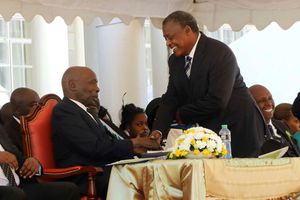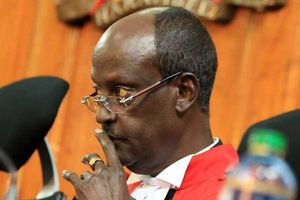Premium
IMF’s bitter pill for President Uhuru Kenyatta’s successor

IMF headquarters in Washington, DC. President Uhuru Kenyatta’s successor faces a headache after the IMF pressed for the scrapping of the current populist interventions including petroleum and electricity subsidies
President Uhuru Kenyatta’s successor faces a headache after the International Monetary Fund (IMF) pressed for the scrapping of the current populist interventions including petroleum and electricity subsidies meant to appease restless Kenyans hit hard by the economic fallout of the Covid-19 pandemic.
With just 17 days to go to the August 9 General Election, leading presidential candidates Raila Odinga and William Ruto — both promising populist moves to cut cost of basic commodities, reduce cost of credit and dish out interest-free loans to the youth and small enterprises — will have to deal with the IMF headache, which will spill over to the next administration.
Additional lending to Kenya
The IMF on Monday approved an additional Sh28 billion ($235.6 million) lending to Kenya in the third review of the country’s extended fund facility and extended credit facility, bringing the total amount that Kenya has received from the lender since the start of the 38-month programme in April last year to $1.2 billion (Sh142.2 billion).
But the loan comes with unpopular demands that will certainly ruffle feathers — including freezing further reduction in electricity costs through subsidies and ending cushions for consumers against high petroleum prices through state compensation to oil marketers.
New tax policy
Additionally, the Bretton Woods institution has renewed its push for a new tax policy by the Treasury — laying clear outcomes citizens should expect from a programme that has effectively returned IMF to the control of Kenya’s key policy decisions.
“Looking ahead, the authorities should sustain their fiscal consolidation efforts to reduce debt vulnerabilities, while securing space for needed social and development spending. This requires further improving spending efficiency and undertaking additional tax policy and revenue administration measures drawing from the forthcoming Medium-Term Revenue Strategy,” stated Ms Antoinette Sayeh, IMF’s deputy managing director.
The front-runners in the presidential election race have both promised to cushion Kenyan households from the high cost of living using some of the populist measures now targeted for removal by the IMF.
Interest-free loans
Dr Ruto and Mr Odinga have promised interest-free loans, multimillion-shilling stimulus programmes, as well as a sharp decrease in the cost of fuel, and basic commodities such as flour and milk.
Already, the National Treasury has issued a draft national tax policy, in which it proposes, among other actions, to expand taxation on the country’s agriculture and informal business sectors. It proposes to introduce a pre-emptive tax on agriculture — a levy usually imposed on those whose income is low or those who are not covered under usual tax coverage.
Currently, small-scale farmers do not pay income tax on their earnings and the Treasury expects to net thousands of growers, especially those dealing in cash crops like tea, and sugarcane.
Much of Kenya’s agriculture is subsistence farming run by peasant households. “To progressively increase tax yields from hard to tax sectors, the government will explore ways of enhancing taxation in the agricultural sector and the informal sector, including the use of presumptive tax, roll out education programmes to farmers and informal sector groups on taxation and business including registering with respective sub-sector associations and co-operative societies,” Treasury states.
Preferential tax rate
Through its proposed tax policy, the Treasury is also seeking to set the minimum value-added tax (VAT) rate at 12 per cent — pointing to an increase in taxes on goods such as fuel and cooking gas if the proposal is adopted. The draft National Tax Policy proposes that all goods should be taxed at 16 per cent and the preferential rate should not be lower than 12 per cent.
“In the year 2020, there are two general rates of VAT: eight per cent for petroleum products, 16 per cent for other goods/services, and zero per cent for exported goods. The rate on petroleum goods creates undue advantages over other goods,” the draft tax policy reads. “There shall be a single general rate for VAT and where a preferential rate is granted, it shall not be lower than 25 per cent of the general rate,” the policy further states.
VAT on fuel
President Kenyatta was in 2018 forced to halve VAT on fuel to eight per cent after the introduction of the full tax prompted protests from motorists and business lobbies.
Runaway inflation has forced the government to subsidise the cost of select key commodities to cushion consumers from a high-cost living and stimulate production in key sectors of the economy. For example, the government disbursed Sh3 billion for fertiliser subsidy for farmers between the April and June planting season and has allocated a further Sh2.7 billion for the next planting season in October.
It has also been subsidising fuel prices since last year amid record-high prices that have had a ripple effect on the cost of other goods and services, including electricity, food, and transport. Last week, President Uhuru Kenyatta handed Kenyans a major reprieve from an expected increase in fuel prices increase by moving the National Treasury to unleash Sh16.67 billion for the subsidy to retain the current fuel prices.
Stop subsidy interventions
The IMF, however, wants most of these subsidy interventions stopped to ease pressure on the country’s thinned resource envelope — a demand that Kenya has committed to honour.
“We have started to gradually realign domestic fuel prices to global prices by increasing pump prices by, on average, 4.1 per cent on March 15, 8.1 per cent on April 15, 4.1 per cent on May 15, and 6.5 per cent on June 1,” the National Treasury said in a submission to the IMF on the fuel subsidy.
The Treasury about two weeks ago cut VAT charged on cooking gas by half, handing consumers a major relief amid rising global prices of the commodity and other petroleum products.





